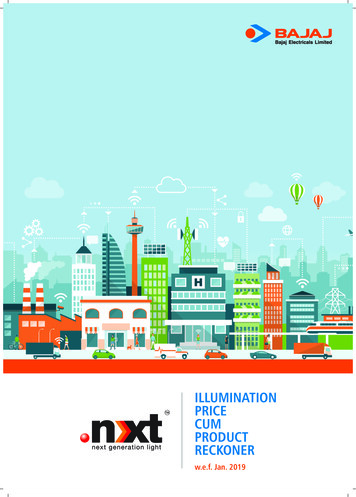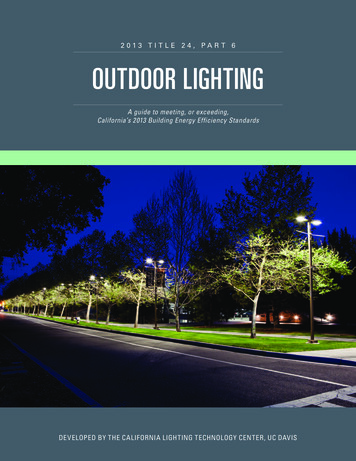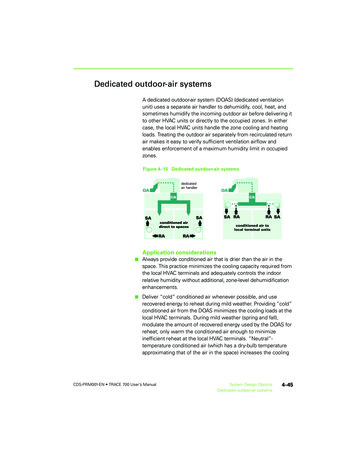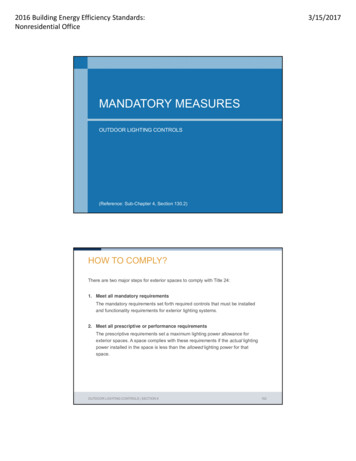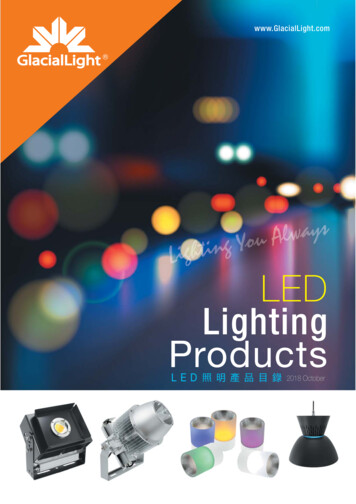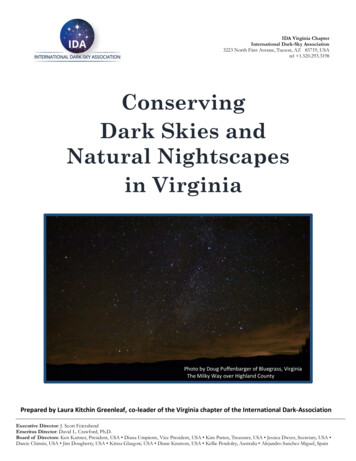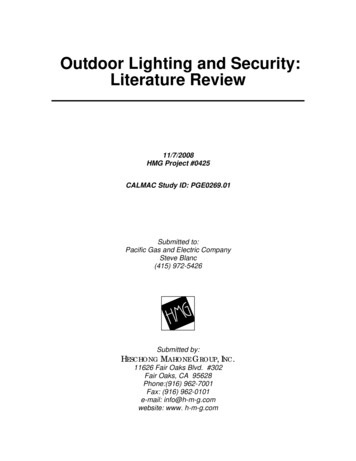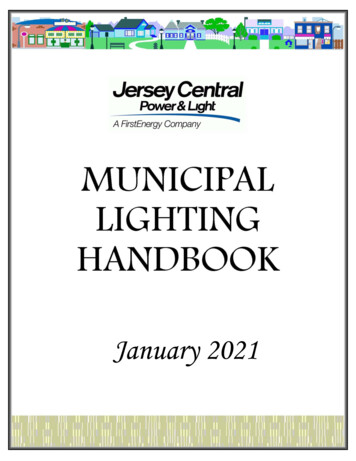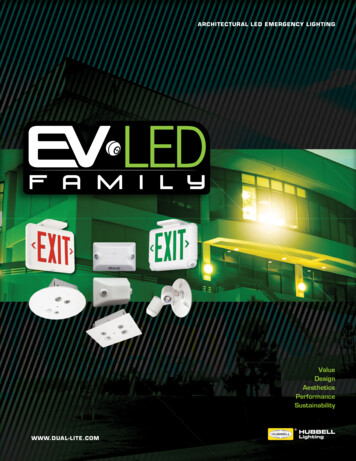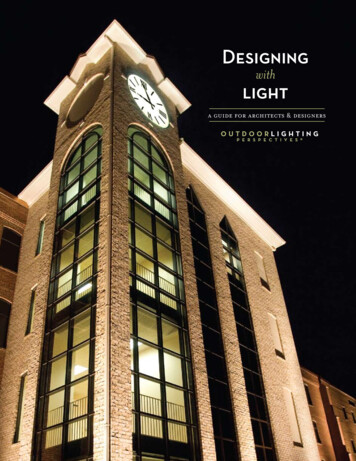
Transcription
Designingwithlighta guide for architects & designers
On existingbuildings,we can even offer you a freedemonstration. You’ll be ableto see in advance exactly whatimaginative landscape andarchitectural lighting cando for your property.
Our designers evaluateeach installation individually. We begin by establishingyour goal. Do you want your building to “pop” or doyou prefer a more subtle approach? Is there a particulardramatic effect or mood you want to create?Then, we study your site. From the colors and texturesof your building, to the unique architectural andlandscape features of your property, every detailis carefully evaluated to create a lighting schemethat will highlight your best assets.
Beyond foot candles,our designers look at the lumens and the color temperature.We rely heavily on the Color Rendering Index (CRI) todecide which light source to best highlight each architecturalfeature.Of course, we also weigh the efficiency, life and durabilityof the bulb against its CRI value and intended use. Usually,an installation will use a combination of different wattagebulbs and lighting effects for maximum appeal andoperational efficiency.
A few inches of variance on each beamcan mean the difference betweenordinary and extraordinary.
Each fixture is thoughtfully designed with a timeless styling thatgraciously blends with natural landscaping. Many can be powdercoated in custom colors to meet your individual needs.Quality is the hallmark of Outdoor Lighting Perspectives. Qualityfixtures. Quality design. Quality service. Our installations are builtto last.
Quality is the hallmark of Outdoor Lighting Perspectives.
TheCommercial FixtureCut SheetsOutdoor lighting design is first and foremostabout the light.
lc-07medium range bollardp r o d u ct h i ghlightsAll external stainless steel (except when powder coated)and incorporates green technology. This marine-gradefixture is dark skies compliant. Smaller than anything elseon the market, our LC-7 Medium Range Bollard mountsin concrete or in-ground, features a replaceable reflectorand can be custom powder-coated in virtually any color.This fixture has great range without the size and hot spotsof traditional bollards.s p ec i f i cat i onsconstructionAll external parts stainless steelSome mounting components zinc-platedMounting components available in all stainless steel24" shaft height30" shaft heightLight source concealed in baseLight source covered by tempered glass lensfinishPolished stainless steelBrushed stainless steelPowder-coated standard bronze or dark greenPowder-coated custom colors availabledirectivityThrows an even round circle of lightmountingConcrete mounts with 3/8”rodsLeveling feature in baseLarge 5 1/2” diameter, 24” long PVC rocket mountwith cast aluminum cap available for ground installationsVandal resistant mount availablea new directionin commercial landscape lighting9 D/e"electrical120 volt ballastMulti-volt ballasts available9 D/e"lamp20-watt Par 20 ceramic metal halide39-watt Par 20 ceramic metal halide75-watt MR16 low voltage30"24"2H/i"
24" pipe - Horizontal foot-candles at radius from 28" fixtureRadius39 watt CMD20 watt 1.00.60.30.20.130" pipe - Horizontal foot-candles at radius from 34" fixtureRadius39 watt CMD20 watt .90.60.40.20.1a p p l i cat i o nIllumination of sidewalksPath illuminationSecuritywa r ra n t yOne year limited warrantyas f e at u r e d i nArchitectural DigestLandscape ArchitectureAnd other fine ing.OutdoorLights.com 2009 Outdoor Lighting Perspectives
lc-10versatile flood lightp r o d u ct h i ghlightsIncorporating green technology, this fixture has majesticscale and is extremely rugged. Featuring constant colorthrough bulb life, our LC-10 Versatile Flood Light mountsin concrete or in-ground, can be custom powdercoated in virtually any color, and offers outstandingcolor rendition for architectural elements and signage. Aversatile fixture with style that is excellent for a multitudeof different tasks. Outstanding choice where longevityand environmental corrosion is a concern. Its superior colorrendition and CRI make this fixture a great choice forany classical landscape lighting application.s p ec i f i cat i onsconstructionAll external stainless steelSome mounting components zinc-platedMounting components available in all stainless steel24" shaft height36" shaft heightCustom height availablefinishPolished stainless steelBrushed stainless steelPowder-coated standard bronze or dark greenPowder-coated custom colors availabledirectivitya new directionin commercial landscape lighting45 fixed orientation of headConfiguration as an up-light or down-lightmountingConcrete mounts with 3/8”rodsLeveling fixture in baseLarge 5” diameter, 24” long PVC rocket mount with castaluminum cap available for ground installationsSurface wall mounts available4"4"electrical120 volt ballastMulti-volt ballasts availablelamp20-watt single-ended ceramic metal halide39-watt single-ended ceramic metal halide70-watt single-ended ceramic metal halide36"24"
photometricset backapprox beam size70 watt foot-candles5'6' x 13'30 max / 15 min10'12' x 25'7.5 max / 3 min15'23' x 45'3.3 max / 1.6 min39 watt 55% 70w ft-c20 watt 28% 70w ft-capplicationIllumination of walls up to two storiesSign illuminationPath and step illuminationTree illuminationLow planting area illuminationSecuritywarrantyOne year limited warrantyas featured inArchitectural DigestLandscape ArchitectureAnd other fine ing.OutdoorLights.com 2009 Outdoor Lighting Perspectives
lc-15up/down lightp r o d u ct h i ghlightsThe LC 15 Up/Down fixture is the ultimate forcommercial and residential lighting. Made of castaluminum, these fixtures blend well with exteriorlandscaping. The light sources are ceramic metal halidelamps, incorporate green technology and provide a colorrendering index above 90.s p ec i f i cat i onsconstructionAll external metal parts are aluminumfinishPowder-coated standard bronzePowder-coated custom colors availablemountingMounting plate attaches to the connections boxLC15 attaches to the mounting plate with stainless steelset screwswall boxProvides mounting for up to two 20, 39 or 70 wattelectronic ballastlamp20, 39 and 70 watt PAR 30 ceramic metal halideLamps available in varying beam spreadsIES photometric files availablea new directionin commercial landscape lightinga p p l i cat i o nIllumination of sidewalksPath illuminationSecurityWall and architectural featureswa r ra n t yOne year limited warrantyas f e at u r e d in16"8"Architectural DigestLandscape ArchitectureAnd other fine publications4 b/c"9 b/c"
P h oto m et r i c l ege n Lights.com 2009 Outdoor Lighting Perspectives
lc-20directional accent lightp r o d u ct h i ghlightsCrafted from cast brass, this fixture’s decorative hoodadds extra protection to the tempered glass lens.An exceptional accent light for illuminating trees, smallerbuildings and all landscaping. Super energy-efficient,incorporating green technology, our LC-20 DirectionalAccent Light offers variable beam spreads in an extremelycompact size.s p ec i f i cat i onsconstructionCopper finish over solid cast brassfinishCopper finishDevelops natural patina over timedirectivityAdjustable up-lightingAdjustable down-lightingmountingLarge knuckle with internal teeth1/2" NPT mount connectionLarge 5” diameter, 24” long PVC rocket mount withcast aluminum cap available for ground installationsRemote ballast components available for tree andsurface mountinga new directionelectricalin commercial landscape lighting120 volt ballastMulti-volt ballasts availablelamp20-watt Par 20 ceramic metal halide39-watt Par 20 ceramic metal halideMedium flood and narrow spot availablea p p l i cat i o n8 D/i"Illumination of sidewalksPath illuminationSecuritywa r ra n t yOne year limited warrantyas f e at u r e d inArchitectural DigestLandscape ArchitectureAnd other fine publications3 F/i"3 B/e"
photometricset back5'10'15'approx beam size6.5'13'25'39 watt foot-candles130 max / 65 min33 max / 16 min14 max / 7 min20 watt 50% 39w oorLights.com 2009 Outdoor Lighting Perspectives
lc-38ALbullet fixturep r o d u ct h i ghlightsCrafted from bronze powder coated aluminum, thisfixture’s decorative hood adds extra protection tothe tempered glass lens. An exceptional accent light forilluminating trees, smaller buildings and all landscaping.Super energy-efficient, incorporating green technology,our LC-38AL Bullet Fixture offers variable beam spreads inan extremely compact size.s p ec i f i cat i onsconstructionBronze powder coated aluminumfinishBronze powder coateddirectivityAdjustable up-lightingAdjustable down-lightingmountingLarge knuckle with internal teeth1/2" NPT mount connectionLarge 5” diameter, 24” long PVC rocket mount withcast aluminum cap available for ground installationsRemote ballast components available for tree andsurface mountingelectrical120 volt ballastMulti-volt ballasts availablea new directionin commercial landscape lightinglamp70, 100 and 150-watt PAR 38 ceramic metal halideLamps available in varying beam spreadsIES photometric files availablea p p l i cat i o nArchitectural featuresIllumination of sidewalksPath illuminationSecuritywa r ra n t yOne year limited warrantyas f e at u r e d inArchitectural DigestLandscape ArchitectureAnd other fine publications14.4"5.3"
P h oto m et r i c l ege n Lights.com 2009 Outdoor Lighting Perspectives
lc-38BRbullet fixturep r o d u ct h i ghlightsThe LC38 BR bullet fixture is the ultimate for commercialand residential landscape lighting. Made of cast brass witha copper finish, these fixtures blend well with exteriorlandscaping. The light sources are ceramic metal halide,incorporate green technology and provide a color renderingindex above 90.s p ec i f i cat i onsconstructionAll external metal parts are cast brassmountingLarge knuckle with internal teeth1/2“ NPT mount connectionLarge 5” diameter, 24” long PVC rocket mount withcast aluminum cap available for ground installationsRemote ballast components available for tree andsurface mountingballasts70, 100 and 150 watt universal voltagelamp70, 100 and 150 watt PAR 38 ceramic metal halideLamps available in varying beam spreadsIES photometric files availablea p p l i cat i o nArchitectural featuresIllumination of sidewalksPath illuminationSecuritywa r ra n t yOne year limited warrantyas f e at u r e d inArchitectural DigestLandscape ArchitectureAnd other fine publicationsa new directionin commercial landscape lighting
Photometric tdoorLights.com 2009 Outdoor Lighting Perspectives
lc-40pole lamp postp r o d u ct h i ghlights20B/C "The LC 40 series lamp posts are the ultimate forcommercial and residential landscape lighting. Madeof cast and extruded aluminum, these fixtures blend wellwith exterior landscaping and are dark sky compliant. Thelight source is ceramic metal halide and uses greentechnology while producing a color rendering index above 90.32"s p ec i f i cat i onsconstructionAll external parts are cast aluminumTop is polycarbonate and aluminumfinish120", 144", 168"Powder coated in black, Belle Meade green, bronze andcustom colorsmountingConcrete mounted fixture uses four 1/2 inch boltsheightOverall height 10, 12, and 14 feetlamp70, 100 and 150 watt ceramic metal halideIES Photometric file available for Type III defuserwith 150 watt CMHa p p l i cat i o nIllumination of sidewalks and parking areasPath illuminationSecuritywa r ra n t yOne year limited warranty9 D/e"as f e at u r e d inArchitectural DigestLandscape ArchitectureAnd other fine publicationsa new directionin commercial landscape lighting
Photometric legend1 . 8 0 0. 4 47.1 1 1 2Commercial-Outdoor-Lighting.OutdoorLights.com 2009 Outdoor Lighting Perspectives
lc-50BFbox flood lampp r o d u ct h i ghlightsThe LC50 BF box flood lamps are the ultimate forcommercial and residential landscape lighting. Madeof cast aluminum, these fixtures blend well with exteriorlandscaping. The light source is a ceramic metal halidelamp, incorporates green technology and provides a colorrendering index above 90.s p ec i f i cat i onsconstructionAll external metal parts are cast aluminumfinishPowder coated in bronzemountingMounting plate attaches to the connections box. LC50attaches to the mounting plate with stainless steel setscrews. Wall box provides mounting for electronic ballast.lamp39, 70, 100 and 150 watt ceramic metal halideIES Photometric file available for 150 watt CMHballasts39, 70, 100 and 150 watt universal voltagea p p l i cat i o na new directionin commercial landscape lightingIllumination of sidewalksPath illuminationSecuritywa r ra n t yOne year limited warrantyas f e at u r e d inArchitectural DigestLandscape ArchitectureAnd other fine publications1 0"5 D e"
ights.com 2009 Outdoor Lighting PerspectivesPhotometric legend
TheCommercial FixtureWhite PapersOutdoor lighting design is first and foremostabout the light.
white paper:Illumination Accents
THE ART OF ILLUMINATIONTo achieve truly stunning lighting, one must understand both the science of light and the art of illumination. The dark of nightpresents the lighting designer with a blank canvas upon which to literally paint with light. The skilled lighting designer cancreate distinct moods, make objects appear or disappear, or even change the surrounding colors and textures.Every project begins by identifying the specific goals the lighting is to achieve. For instance, what are the aesthetic goals?Should the area appear Inviting? Haunting? Dramatic? Is security a concern? Are there safety issues to be addressed alongwalkways, stairs or uneven surfaces? Are outdoor areas to be used as living spaces or entertainment areas? The list goes on.An exhaustive evaluation of all concerns must be accomplished before any planning can begin. Once the goals are determined,the lighting designer has a powerful toolbox to draw from. The first of these tools is color.COLORIn the absence of natural light, the world’s color is largely in the hands of the illuminator. Every object absorbs and reflectslight. The object’s color lies in the light it reflects. A school bus reflects yellow light; a fire engine reflects red light. But, whathappens if there is no yellow or red light? The school bus appears black, as does the fire engine.CRIBy manipulating the color of the light, the lighting designer can create a mood by popping targeted colors or subduingunwanted colors. The light source itself need not appear overtly colored to affect the colors of the objects around it. This is whythe lighting designer relies on another important tool, the Color Rendering Index (CRI).The CRI rates light on a scale of 0 to 100. The bottom of the scale is darkness. The top is equivalent to the noon sunon a cloudless day. At the top, 100 CRI indicates a white light incorporating the full spectrum of color wavelengths. If a surfaceincorporated 30 different shades of blue, all 30 would be visible at 100 CRI. But, drop down to a CRI of 60 and perhapsonly 5 different shades of blue would be distinguishable.APPEARANCE OF NATURAL LIGHTIn most applications, the lighting designer will want the light to appear natural. That calls for the lamp (“lamp” is the industry’sterm for “light bulb”) to have a CRI of 80 or above. To literally match daytime colors, a CRI of 95 or higher is required. Whileplaying with color can create dramatic results, the rule of thumb is that less is usually more. Natural lighting is always pleasingto the eye.COLOR TEMPERATUREAnother key tool in the lighting designer’s arsenal is color temperature. This temperature isn’t about the kind of hot and coldyou can feel with your hand. Rather, it’s about the hot tones or cold tones perceived by the eye. Color temperature measuresthe light you see along the visible spectrum. The unit of measurement used is degrees Kelvin. Interestingly, the perceived heatof a color relates inversely to its measurement in degrees Kelvin. For instance, the hottest visible color is red, which is 1500degrees Kelvin, the lowest measure of visible light on the Kelvin scale. The cooler colors, such as blue, measure higher on theKelvin scale. The highest visible light on the Kelvin scale is violet, which is 10,000 degrees Kelvin.In the past, light sources that produced cool blues or warm reds would have low CRI numbers. However, recent advancesin technology now allow manufacturers to produce bulbs with identical CRIs above 85, but with different color temperatures.For instance, in ceramic metal halide lamps with a CRI of 85, we can now choose either 3000 degrees Kelvin (for a warmer“feeling”) or 4000 degrees Kelvin (for a cooler “feeling”). Differing color temperatures in lamps of the same CRI are alsoavailable in fluorescent and LED lights. This allows the lighting designer to adjust the perceived temperature of the light whilestill accurately reflecting the natural colors of landscape and/or architecture.2
MOONLIGHTOften, a lighting designer will want to achieve the feeling of moonlight. Moonlight is, of course, a very natural effect.Yet, moonlight can create a romantic or magical mood. In creating a moonlight effect, the illuminator will “pop” the coolblues and greens of the landscaping. This is usually best achieved with mercury lamps. However, when it’s importantto accurately reflect the colors of the architecture, mercury lamps (with CRIs in the 40s) may only work with certainbuilding colors (those on the blue end of the spectrum).YELLOW TONESWhen it’s desirable to punch up yellow tones, high-pressure sodium lamps are an ideal choice. These can bring out theyellow accents in a beige building quite nicely. Street lights are usually high-pressure sodium lamps. However, these aregenerally too yellow for residential applications.SIGNAGEFluorescent lighting technology has come a long way in recent years, with improved phosphors in the bulbs resultingin CRIs of 90 . However, fluorescent lamps are still sized too long for most outdoor lighting applications. The one placewhere fluorescents are ideal is in lighting signage where their linear format and high CRI combine with great energyefficiency for an unbeatable performance.ACCENTING SURFACESSometimes the surfaces of a wall or walkway are vital elements in establishing the personality of a property. The textureof brick, rock or stucco makes an important aesthetic statement. Likewise, contrasting or complementing colorson adjacent surfaces can be a large part of the personality of a building. In these cases, it’s vital to light the surfacesin a way that accurately portrays – or enhances – the true colors and textures of the surfaces. In these cases, quartzhalogen or ceramic metal halide lamps with CRIs in the 90s would be the preferred light sources.MULTIPLE SOLUTIONS FOR SIMILAR LIGHTING EFFECTSThere’s often more than one lighting solution to achieve a desired effect. For instance, let’s take the example of a buildingwith a limestone and blue marble façade and a limestone entrance. Of course, one of the goals would be to draw attentionto the entrance. This can be achieved by directing a brighter light source on the entrance while grazing the rest of thebuilding with lower wattage lamps. Or, you could use a warmer 3000 degree Kelvin light source or a higher CRI lightsource on the limestone entrance, while illuminating the remainder of the building with cooler or lower CRI lamps.Any of these solutions would produce the desired contrasting effect.DIRECTIONAL LIGHTINGPlacement is just as important as color and color temperature in any given lighting design. In placing lights, it’s importantto consider which features define the property, the shape and textures of the surfaces to be lit, the shadows the lightmay cast, visibility and safety issues, maintenance issues, light spillage, and interaction with the surrounding landscapeas seasons change and plants mature.UP LIGHTINGDirecting light upward from ground level dramatically highlights key architectural and landscape features.A different lighting angle than ever occurs naturally, up lighting stands out with a bold, unique look. Light-pollutionconcerns can be addressed by careful aiming combined with use of the proper lamps and fixture shields. Whenup lighting residential buildings, placement and beam width must be carefully addressed to prevent light spillage intobedroom windows.Lighting designers must also carefully consider landscape issues when up lighting. Will growth patterns cause plantsto block the lighting as the plants mature? Will the proximity of deciduous trees cause debris to block lights in the fall?Will snowfall patterns render lights ineffective throughout the winter? Etc.3
DOWN LIGHTINGIlluminating an area or architectural element from above is often the best choice for safety, security or special effect.Lights shining down from above can illuminate a broad area, are difficult to tamper with, and are less likelyto be hampered by landscape or weather concerns.Bulb selection for down lighting involves practical as well as aesthetic and functional issues.For commercial applications, maintenance costs should be a major part of the equation. Maintenance issues shouldalso be factored into residential installations. Homeowners opting to maintain their fixtures themselves may be betterserved by extremely long-lived lamps or a more accessible alternative to down lighting.WALL WASH LIGHTINGSoft illumination accenting the texture of a wall surface can make a stunning aesthetic statement.AREA LIGHTINGOften, practical issues will require that a large area is illuminated without accentuating any specific object or feature.When lighting an area, the main purpose of that area will play a major part in lamp and wattage selection.For instance, an area used for outdoor sports would require special attention to assure that depth perceptionis addressed as some lighting can “flatten” perception. Areas used for swap meets would require true color andgreater visibility than areas used to host social gatherings (where a moodier lighting may be appropriate). Etc.SPOT LIGHTINGA tree, statue, flag, fountain or architectural feature is often best highlighted by a spot light. An importantconsideration in spot lighting is directing the light in a way that enhances the subject without creatingundesirable shadows, glare or light spillage.SHADOWINGA skilled lighting designer can create magic with dark space as well as light. Causing a tree, fountainor architectural element to cast a shapely shadow against a wall can create enormous visual interest.SILHOUETTINGBacklighting can be artfully used to show off boldly shaped details. Silhouetting is highly effective whenan interesting pattern or unusual shape occupies the foreground.SECURITY LIGHTINGThe elimination of hiding spots is but one concern when lighting to increase security. Attention must be paidto eliminating glare (for superior visibility). Security lights should be strategically placed so the entireperimeter and all access points are properly lit.PATHWAY LIGHTINGIlluminating walking surfaces with light projected from knee height or above is both aesthetically pleasing anda great enhancement to safety. Special attention should be paid to areas with uneven surfaces or steps. Pathwaylighting should be free from glare and allow depth perception. Pathway lights are particularly helpful whenpaths will be traveled by unfamiliar visitors and/or elderly individuals, when vegetation crowds pathsor displays the potential to grow over paths unnoticed, and at homes where children or others are proneto leave objects strewn about. Pathway lights are important enhancements that can help prevent injuriesand lawsuits.MOONLIGHTINGShining a mercury lamp down from a tree can create the illusion of moonlight. This is particularly desirableadjacent to buildings or on densely treed lots where natural moonlight may be blocked.4
WATER AND POND LIGHTINGUnderwater lighting can add general illumination for both beauty and safety. Underwater lighting can alsohighlight underwater objects or murals and is lovely at a waterfall.STEP LIGHTINGIlluminating a step or group of steps can greatly improve visibility and safety. Step lighting can include lightson risers, LED lights embedded along step edges, lights under steps without risers, side lights, or anycombination thereof.EFFECTS, NOT FIXTURESWhile many gorgeous outdoor lighting fixtures exist and can certainly play an important part in lighting design,the most important aspect of illumination is the lighting effect. In fact, brilliant lighting design most often hides thefixtures so that the light seems an integral part of the landscape or architecture. Artful lighting is unobtrusive, itssource illusive, its effects dramatic.5
white paper:The Science of Light
THE SCIENCE OF LIGHTWhen it comes to outdoor lighting, the “wow” factor comes from the total lighting effect. And that effect has verylittle to do with the fixture and everything to do with the light source. The light source, or “lamp” as it’s calledin the industry (“light bulb” in consumer-speak), can be any of a number of popular lighting technologies, each withits own advantages and limitations.In order to compare lighting technologies, it’s important to understand a few basic properties of light, lamps and howeach is measured.PROPERTIES AND MEASUREMENTS OF LIGHT:FOOT CANDLESFoot candles are extremely important in commercial lighting applications as most municipalities have foot candlestandards that must be met when lighting stairs, sidewalks and parking lots. A foot candle is the measurementof the amount of light reflected off the ground. One foot candle would be the equivalent of the light of one candlereflected within a one-foot sphere.As you move further away from a light source, the reflected light (and thus, the foot candles) diminishes. For instance,if you have 10 foot candles directly beneath your light source, you may have only 5 foot candles two feet away and3 foot candles three feet away. So, if a code requires 10 foot candles in a parking lot, the lighting designer must factorin the distances between fixtures and assure that the light will be at least 10 foot candles at the midpoint betweenfixtures.LUMENSLumens refer to the amount of light radiating directly from a light source (basically, a measurement of the brightnessof the lamp). Lumens are an important measurement when comparing operating costs of various light sources. Wattsmeasure the electricity consumed by the lamp, so the more lumens per watt, the more energy efficient the lamp is.COLOR TEMPERATUREColor temperature isn’t about the kind of hot and cold you can feel with your hand. Rather, it’s about the hot tonesor cold tones perceived by the eye. Color temperature measures the light you see along the visible spectrum.It is measured in degrees Kelvin.Interestingly, the perceived heat of a color relates inversely to its measurement in degrees Kelvin. For instance, thehottest visible color is red, which is 1500 degrees Kelvin, the lowest measure of visible light on the Kelvin scale. Thecooler colors, such as blue, measure higher on the Kelvin scale. The highest visible light on the Kelvin scale is violet,which is 10,000 degrees Kelvin.COLOR RENDERING INDEX (CRI)The CRI rates light on a scale of 0 to 100. The bottom of the scale is darkness. The top is equivalent to the noon sunon a cloudless day. At the top, 100 CRI indicates a white light incorporating the full spectrum of color wavelengths.The CRI is important to how surrounding colors are perceived by the viewer. For instance, if a surface incorporated30 different shades of blue, all 30 would be visible at 100 CRI because all light wavelengths would be present. But,drop down to a CRI of 60 and perhaps only 5 of those 30 different shades of blue would be distinguishable. That’sbecause the light wavelengths necessary to perceive some of the colors would be missing. CRIs above 95 are requiredfor true color matching capability, but a CRI of 80 or above is usually acceptable for most applications.2
LAMP LIFEIt’s important to understand that the stated life for any given lamp is the average life of that type of bulb. For instance, if thelamp life is 1,000 hours, some individual bulbs may last 200 hours, others may last 1,800 hours. Individual lamp life canvary greatly. (The exception being ceramic metal halide lamps, which tend to last very near their stated bulb life.) Lamp lifecan be an important maintenance issue that factors heavily into lamp choice in many applications.LAMPS (LIGHT BULBS)Every lamp consists of a glass or ceramic envelope around a light source. Lamps can vary widely in energy efficiency, CRI,bulb life and other important attributes.LIGHTING TECHNOLOGIES:INCANDESCENT LAMPSThese are basically the light bulb you grew up with – the one Thomas Edison invented in the late 1800s. It consists of a carbonfilament in a vacuum inside a lime glass envelope. The filament heats as the electric current passes through it. That heatradiates light.Lumens per wattBulb lifeCRI8-9 (less on longer-lived lamps)750-2,000 hours (bulb life decreases as energy efficiency increases)80-90Advantages Compact size allows light to be directed to specific areas Low cost per lamp Accept
in commercial landscape lighting product highlights The LC 15 Up/Down fixture is the ultimate for commercial and residential lighting. Made of cast aluminum, these fixtures blend well with exterior landscaping. The light sources are ceramic metal halide lamps, incorporate green technology and
